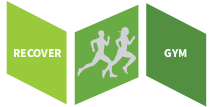Osgood-Schlatter’s disease
Rehab træning af skaden
Focus on training the rest of the body, so you do not lose your current mobility, stability and strength. Then find out what you can do from workout programs and work out according to the level you have. Exercise of the rest of the body accelerates healing of your injury, among other things due to increased nerve activity and circuits.
Description of Osgood-Schlatter’s disease
Osgood Schlatter’s disease is similar to the jumper’s knee but is located where the kneecap tendon (patella ligament) is attached to the bone elevation under the knee, at the top of the tibial bone (tibial tuberosity). There is no clear indication as to why the attachment site for the tendon gets irritated and inflamed. The best guess local overload of the tendon, misalignment of the pelvis or asymmetry of the lower legs and foot, which most often affects young boys in the age of 10-16 and is rarely seen after the end of the growth period, i.e. 17-18 years of age. The disease is therefore not seen in connection with trauma. An overly tight quadriceps muscle (the four-headed knee stretching muscle) can be one of many reasons which cause the condition to develop. Therefore, after a long period of time without improvement, it may be advantageous to hire an expert, the expert can determine whether there are imbalances in the pelvis, hip, etc. that are aggravating the condition.
Symptoms of Osgood schlatter’s disease syndrome
- Pain at the site of attachment for the tendon on tibial tuberosity.
- The pain is triggered by loading the quadriceps muscle, the pain can be triggered immediately for some or with loading over time for others.
- Swelling over the attachment of the tendon.
- Signs of inflammation of the area.
Examination
- Analysis / Inspection / Palpation / ROM (visual and physical comparison with opposite side).
- Palpation of the kneecap’s tendon.
- Ely test.
- X-ray examination can show any fraying of the bone.
Treatment for Osgood schlatter’s disease syndrome
- Rehab 1.
- Active rest.
- Loading to pain limit.
- Taping or neopren bandage with velco.
- Thermo / Cryo therapy.
- Ultrasound (continuous / pulsating), 3 Mhz, 0,5-1 W cm2.
- NSAID gel or Traumeel (2 tablets 3 g. daily for 9 days).
- Massaging the quadriceps muscle.
- Kinesiology tape.
- K-laser.
The doctor may, in cases where the injury is not kept immobile enough, choose to apply a cast for 4 weeks, thus achieving a level of painlessness. Osgood Schlatter’s disease heals on its own and is not seen in adults.


Social Medier